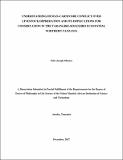| dc.description.abstract | Human-carnivore conflict is one of the threats facing large carnivores across the globe and can have a significant negative financial impact on local people’s livelihoods. Semi-structured interviews were conducted with 300 respondents to examine the level of reported conflict with large carnivores over depredation on livestock, and to assess the key drivers of any such conflict, the financial livestock losses to local communities, the perceived effectiveness of current conflict mitigation strategies and local perceptions and attitudes towards the main carnivore conflict species in the Tarangire-Simanjiro ecosystem in northern Tanzania. Additionally, a spoor-based occupancy modelling approach that incorporates detection probability was used to assess the occurrence of four focal carnivore taxa, and to identify the key environmental and anthropogenic drivers of their occurrence. Of the 300 respondents, 75% reported losses of their livestock to wild predators over the past 1.5 years, which represents an annual loss rate of 1.4% of their livestock holdings. The overall financial loss due to livestock depredation was estimated to be US$ 141,847 (US$ 633/household/year). Reported depredation frequency by all large carnivore species increased significantly with increasing number of livestock owned, respondent’s residency time, distance from the park boundary and declined significantly with increasing education, number of herders and improved fortified boma for cattle. Three-quarters of respondents (79%) held negative attitudes towards large carnivores due to risks of wildlife damage, particularly livestock depredation, while 20% were generally positive linked to potential ecotourism benefits. Education, years at residency and knowledge were the most influential determinants (though dependent on species) of attitudes towards large carnivores than landscape, demographic or economic factors. Fortified bomas (97.7%) and adult herders (71%) were perceived to be the most effective intervention methods to reduce night and daytime depredations respectively. Overall occurrence was estimated at 0.85 (SE = 0.06) for hyena, 0.82 (SE = 0.15) for cheetah, 0.55 (SE = 0.10) for lion and 0.61 (SE = 0.21) for leopard. Lion occurrence was negatively associated with distance to park boundary. Hyena occurrence was positively associated with human population density and negatively associated with bushland, while cheetah and leopard occurrences were positively associated with grassland. These results suggest that lions may be more vulnerable to human impacts than other species, while hyenas may benefit from vicinity to humans. This study provides targeted areas to prioritize for future carnivore conservation efforts and mitigation efforts regarding human-carnivore conflict. | en_US |

